When driving through northern California, I was struck by how little of the state’s land was habitable, with 39 million people crowding mostly along the Pacific coast and the inland valleys. In Arizona, however, the real shock is to see how humans bent the desert to their will.
The Hohokam people dug irrigation canals off the Gila and Salt Rivers more than a thousand years ago, facilitating agriculture to sustain themselves and maintain trade with cultures near and far. After centuries in the valley, the Hohokam largely abandoned their settlements for reasons mostly unknown, but speculated to be related to drought or flooding or alternating states of both.
About 100 years later, the conquistadores arrived in the Sonoran desert, claiming the land as their own1 and rechristening it as New Spain. The indigenous tribes, the Spanish colonists and missionaries, and later the newly independent Mexican rancheros, despite constantly fighting each other over territory, would rehabilitate the Hohokam canals to continue agriculture in this fruitful corner of the otherwise harsh desert.
America’s embrace of manifest destiny brought about war with Mexico,2 eventually leading to cession of land that would become the states of California, Nevada, Utah and, of course, Arizona in 1848. The gold rush swelled the territorial population with new American settlers from the east, taking the land they wanted behind the gun barrels of the U.S. Army. By the time Arizona became a state in 1912, mining and ranching had supplanted agriculture as the leading industries. The cotton fields and citrus orchards that once supported the pioneers — indigenous and colonial, alike — became prime locations for housing. Railroad infrastructure made it possible for the booming population around Phoenix to eat more food imported from the fertile lands to the east and west. More people meant more demand for water, leading to further declines in agriculture and more land for residential development.
With transportation infrastructure in place and reasonably priced real estate aplenty, residents of northern climates could escape the frigid months and instead bask in the dry, mild Arizona winters. The proliferation of air conditioning post-World War II made the now mostly commercial and military economy of the southwest even more attractive for year-round dwellers, as the brutal desert summers could now easily and comfortably be weathered indoors.
In 2024, the Phoenix metropolitan area is the largest in the southwest, the tenth largest in the country, home to more than five million people and continuing to grow, despite, and I can’t stress this enough, being built in a desert. Phoenix is the hottest major city in the United States, registering daily high temperatures over 100 degrees for nearly a third of each year. Arizona continues to battle with California, Colorado and Nevada over water supplies from the Colorado River. Vehicle traffic has led to a decades-long problem with ozone and particulate pollution, with Phoenix being perennially ranked toward the bottom of U.S. cities for air quality.
And still, the people come. They come to play golf in the winter and play on golf simulators in the air conditioning in the summer. They come to sip cocktails on patios in the winter and to knock back beers at the bar in the air conditioning in the summer. They come to climb mountains in the winter and to climb the stairs to the upper deck of Chase Field in the air conditioning in the summer. They come because the desert has been conquered by human ingenuity, or so it would seem.
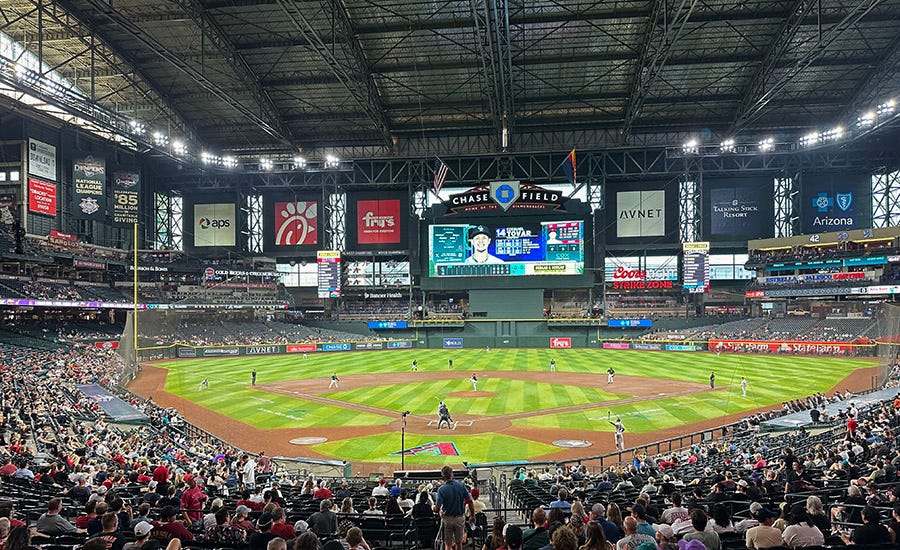
After finally finding my trusty Mazda 3 in the Dodger Stadium parking lot, I hopped on I-10 for Phoenix. That’s a six hour drive through a lot of nothing once you get past Covina, Pomona, Fontana, et cetera. Dinner was a combo meal from a Jack in the Box right off the highway before civilization got too sparse. It was wholly unmemorable, as most fast food is. I sped eastward through the desert, casually watching the sun set from the rearview mirror, casting brilliant gold and copper hues over the distant mountaintops.
It was fully dark by the time I crossed the Colorado River into Arizona. The 110 miles from the state line to the westernmost reaches of the Phoenix metroplex are an almost completely straight line, pitch black after sundown, obscuring the vast emptiness of the desert. After 10 hours of driving from Oakland to L.A. and across southern California, it took all the resolve I had in me — plus a couple of canned cold brew coffees from a roadside truck stop — to stay awake for the final two hour stretch.
I rolled into my downtown Phoenix hotel, the same one Scott and I stayed in when I missed my first chance to visit Chase Field due to COVID, around 11 p.m., dutifully put up the windshield sunshade I had purchased a few weeks prior, checked in with the front desk and crashed out, 760 miles from where I woke up that morning.
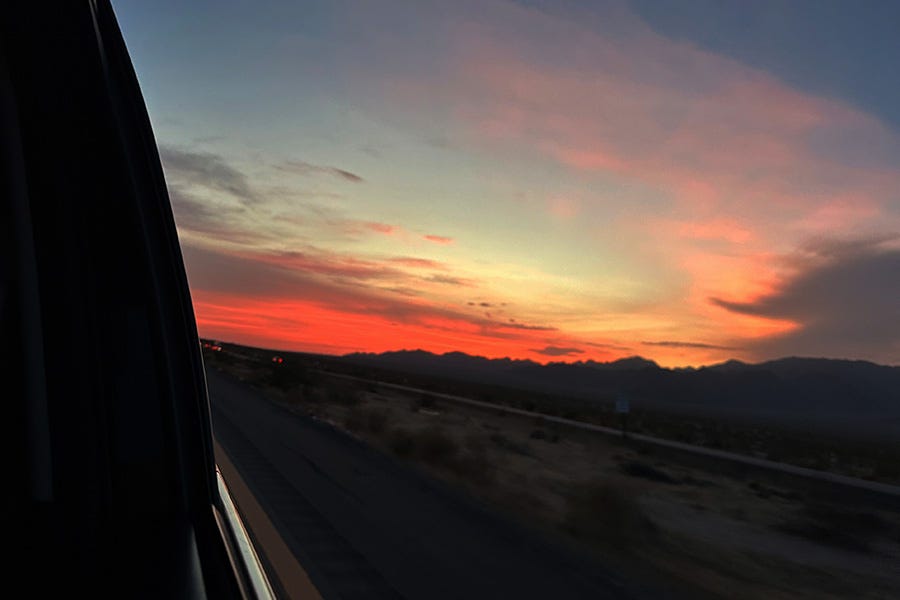
I didn’t really get to explore much of Phoenix last time through, with the exception of my dad’s old stomping grounds in Fountain Hills, an ill-advised stop at Wren House Brewing,3 and the Safeway and Walgreens stores just north of the hotel where we stocked up on food and supplies. However, in the midst of an unprecedented 113 straight days of temperatures over 100 degrees, I was content with basking in the air conditioning in my hotel room for a good long while after waking up.
Once my hunger level finally convinced me to venture outside, I popped in the car, cranked up the AC — the windshield sun shade can only make so much difference in a place like this — and drove a mile to Matt’s Big Breakfast, a solid recommendation from the Moon bible. Huevos rancheros were the Monday daily special, but as I was counting my carbs I ordered The Skinny, a four-egg scramble with chicken sausage, gruyere and spinach served with a side salad. We need to normalize eating salad for breakfast: it was the perfect complement to this dish.
Just north of Matt’s is the 1 1/2 Street Mural Project, located in the heart of the Roosevelt Row Arts District. A dozen muralists have transformed what was once just an alley between 1st and 2nd Streets into a destination for fans of the form. I spent about 20 minutes wandering in and around the alley, checking out the street art that had proliferated beyond the project, before realizing how absolutely hot it was as the sun beat down onto the asphalt and concrete under my feet.
After a quick refresh and recharge back at my air-conditioned hotel, Rob and Andrew of the Arizona Craft Brewers Guild swung by the hotel to pick me up for some pre-game adventure. Obviously it’s too hot to tailgate in Phoenix in the summer, but there are no shortage of hangout options near Chase Field.
First stop was Little O’s 7th Ave. — which is actually on McDowell Road and closer to where 6th Ave. would be, if that particular thoroughfare existed in this part of town — a sister concept of O.H.S.O. Brewery and Distillery. We split a couple of mini-pitchers while Rob and Andrew scarfed down some food; I was still full from my Big Breakfast lunch. I wish I could recommend visiting this place, but they closed their doors about a week after our visit. It’s tough out there for small businesses, especially in the food and beverage space. Inflation on ingredients, packaging, supplies, utilities and rent, coupled with higher labor costs and less discretionary spending by customers who’ve themselves been hit hard by inflation are a recipe for disaster. Support the businesses in your community that you want to stay in your community. There’s no magical bailout coming for them, ever.
For our next round, we went next door to Roses by the Stairs Brewing, and if you think you can guess what the taproom soundtrack is like based on the name, you’re right. I mainly stuck to lighter offerings, primarily in the lager family, but have to give respect to naming a hazy double IPA “Bleed American” after the pride of suburban Phoenix, Jimmy Eat World.
Our penultimate stop was back in the Roosevelt Row at Arizona Wilderness Brewing’s downtown beer garden. Being a Monday at 5:30, there wasn’t a huge crowd inside the taproom, but hardly anyone out on the extensive patio despite being aggressively mist-cooled like many Arizona outdoor spaces are. In the desert. Where water use is a constant concern. And the population keeps growing. And it’s 100+ degrees. Really great beer though.
The last pre-game stop wasn’t one we had planned, but when walking up to Chase Field and about to go through the gates, Andrew realized he had a pocketknife on him. Not wanting to surrender it to security, he took it back to the car while Rob and I ducked into that most authentic of Arizona watering holes: Guy Fieri’s DTPHX Kitchen + Bar. Attached to a Caesars Sportsbook across the plaza from the ballpark,4 this Flavortown colony was doing brisk business a half hour before first pitch, but Rob and I managed to snag a couple bar seats, knock down most of our pints and settle up before Andrew got back.
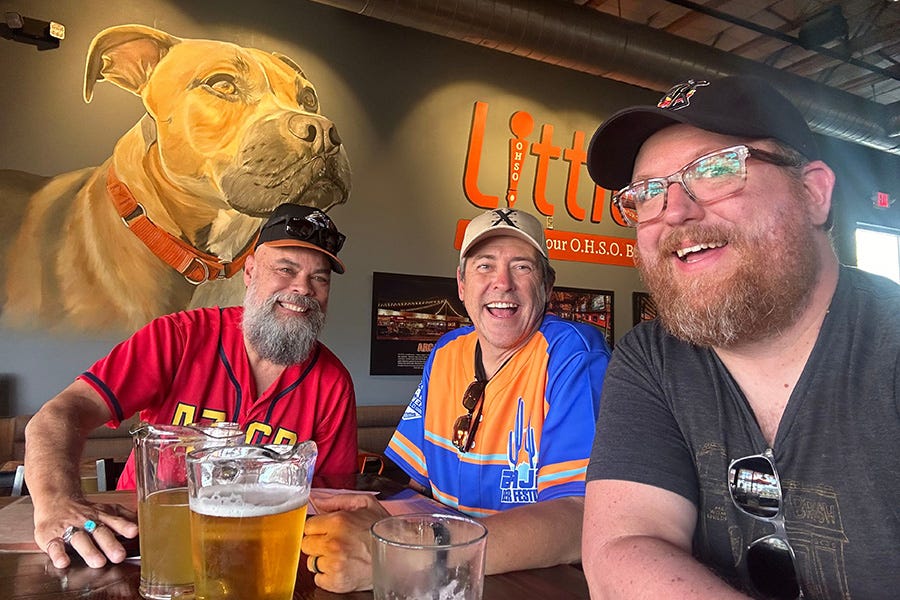
We got through the gates about 10 minutes before first pitch, and I decided to follow my dreams and buy a Serpientes jersey, the Arizona Diamondbacks City Connect series alternate uniform. Most teams’ City Connect fits are garbage — stop trying to make black pants work with blue jerseys; and if there’s a color in your team name, it better be in your uniform design (I’m looking at you, Boston Red Sox) — but Arizona’s is impressive. The Sonoran sand-colored uniform, the cursive “Serpientes” looping and coiling as a snake, the throwback “db” snake head alternate logo… this is not only the best City Connect jersey, it’s making an argument to be included in the upper echelon of baseball jerseys from any league and any era.
I knew before the start of the season that I’d be seeing the Dbacks six times on this journey, more than any other team. After a 2023 season in which they snuck into the playoffs with the last wild card berth, swept the Brewers in a best-of-three series, followed with a sweep of the Dodgers to punch their ticket to the National League Championship Series, won the NL pennant in seven games over the Phillies before falling short in the World Series against the Rangers, expectations for this year’s club were high. At the time of this game, Arizona was playing inspired baseball, having won 15 of 18 contests since the last time I saw them in Kansas City. What better opportunity to show my support for the team I had been low-key rooting for since Opening Day.

Andrew scored us some tickets in the first row of section 105, in the right field stands right next to the visiting Colorado Rockies bullpen. I usually watch the first inning or two from my assigned seat before potentially heading off to other parts of the park, so we made our way out to the bleachers. When we got there, we found that some folks were sitting in our seats, but we didn’t feel the need to evict them considering there were plenty of unoccupied rows in the section.
Attendance was pretty sparse all over the park, actually. The box score put the official attendance at 15,525 — a little less than a third of Chase Field’s capacity — but by my unofficial, unscientific eyeball estimation, I’d put the real number at something closer to 3,000. That’s not terribly surprising, considering it was a Monday night game against a Rockies team tied for the worst record in the National League. However, as mentioned before, the Dbacks were defending NL champs, on a blazing hot streak and vying for a playoff spot. If this were a legacy baseball city like New York, Boston, Chicago, St. Louis, etc., the place would be packed given the circumstances. In Phoenix, a ballgame is just another place with air conditioning.5
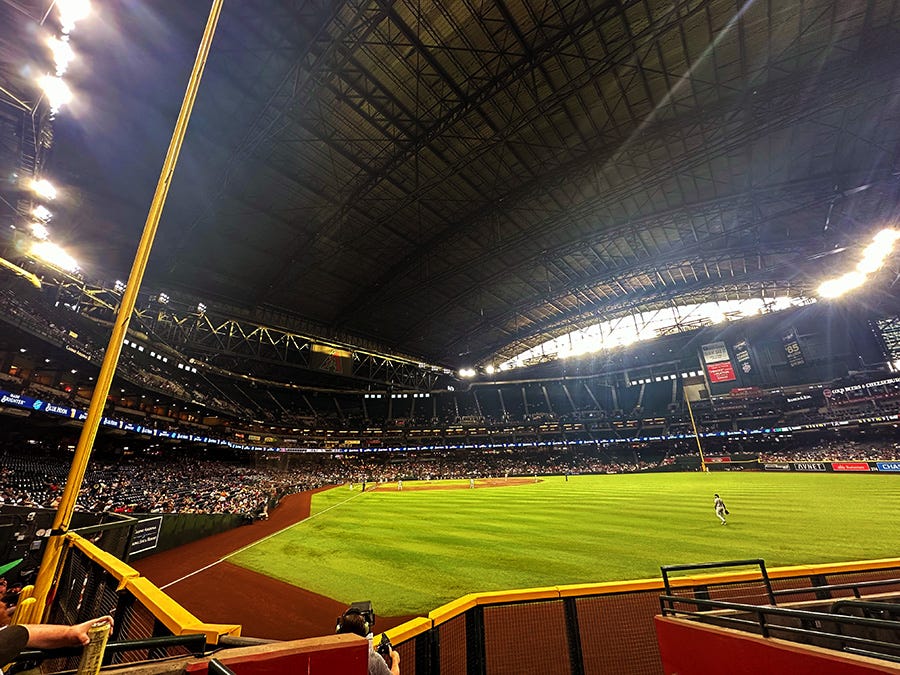
Being beer guys, we strolled around the concourse checking the selection to see how well local brands were represented. As is pretty common practice in most Major League parks, the tap lines and coolers were mostly stocked with big domestics and imports: finding beer from a small, independent, local brewer generally ranges from difficult to nearly impossible. This was my first rodeo at Chase Field, but far from it for Rob and Andrew, so we made our way up to the Cold Beers and Cheeseburgers outpost in the left field terrace.
The sports bar chain operates 16 locations around the valley, including the one built into the ballpark. I didn’t order a cheeseburger, but they definitely delivered on cold beers, offering an array of craft and macro choices on draft, in bottles and in cans at prices that are fairly reasonable compared to the options in the concourse below. The catch: you can’t take your drink from CBCB to other parts of the ballpark. On a busy game night, you likely need a reservation to sit up here too. To me, it’s not an ideal way to watch a ballgame, but it’s not a bad option if your favorite thing about the game day experience is knocking back beers.
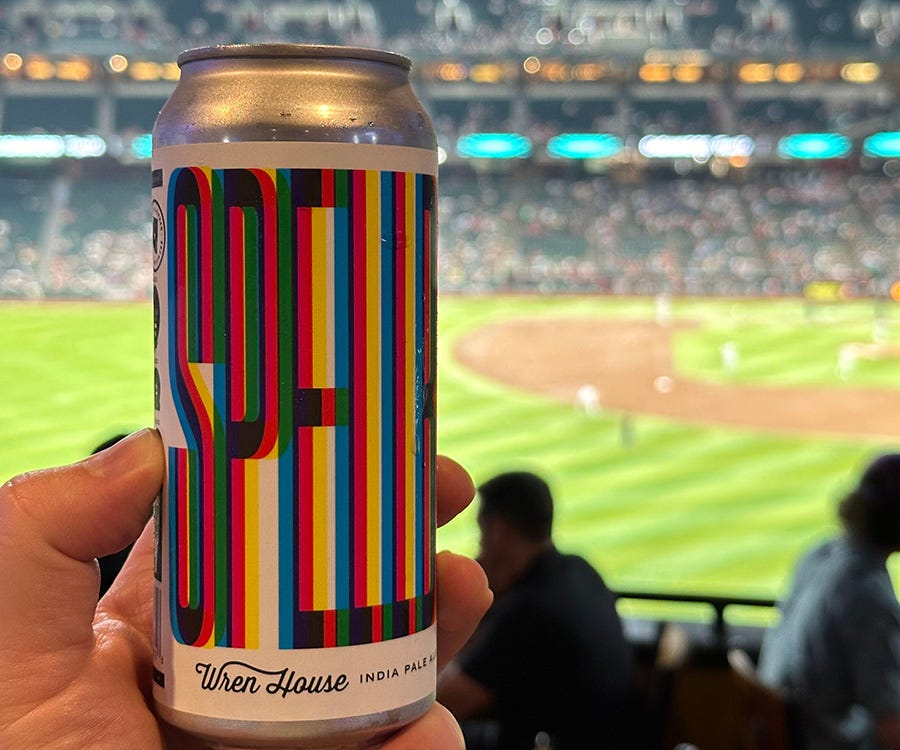
Colorado sent Bradley Blalock to the mound for his first big league start, squaring off against Brandon Pfaadt, one of the up-and-coming young pitchers in the Diamondbacks system. Blalock held his own against the scorching Arizona offense, giving up three runs over five and two-thirds innings. The all-or-nothing Rockies bats hacked away at Pfaadt, plating four runs on eight hits while striking out 11 times in the first seven innings.
Last year’s Arizona team earned the nickname “Answerbacks” for their penchant for late inning heroics. This year’s squad had a little of the same magic in them, starting a two out rally in the bottom of the seventh inning with a single off the bat of outfielder Corbin Carroll, followed by another single by journeyman stopgap second baseman Kevin Newman. After the Rockies called to the bullpen for their erstwhile stopper Tyler Kinley, they gave the Dbacks an opportunity, losing a Joc Pederson pop-up against the backdrop of the closed Chase Field roof, the ball dropping harmlessly in foul ground. Kinley then spiked two consecutive sliders in the dirt in front of catcher Elias Diaz, allowing Carroll and Newman to score and take a 5-4 lead that they would hold over the final two frames.6
We watched the consequential action from the Estrella Jalisco Cantina overlooking right field on the second deck. It’s from this perspective that I fully recognized the artificiality of Chase Field, encased in its protective covering to insulate the game from the harsh environment outside, players patrolling grass-like synthetic turf that replaced the real grass surface the Dbacks played on for their first two decades, bright white LED lights illuminating the field even as natural sunlight spills in over the baselines and peeks through the cracks between the giant video scoreboard and five story advertising banners.

This is the future of baseball, as American civilization continues to convert inhospitable climates into population centers.
The Athletics are moving from the Oakland Coliseum to an indoor ballpark in Las Vegas, less a city and more a mirage in the desert propped up by vice spending and diverted resources.
The Rays longtime home in St. Petersburg was ravaged by Hurricane Milton, leaving them scrambling for a temporary park until their planned fixed-roof stadium is ready in 2028.
Nashville and Charlotte are often name-checked as potential sites for expansion franchises, but both cities actually get more annual rainfall than Seattle, making them prime candidates for retractable roof stadiums.
Texas could add a third team in either Austin or San Antonio, which would likely play in a closed roof environment like their neighbors in Houston and Arlington.
I don’t like this trend. I really enjoyed the two games I’ve seen in Seattle with the roof open, but I’ve heard it’s a considerably worse experience with it closed. The roof at Rogers Centre in Toronto was closed for batting practice and open for the game, so I got to see the place in both states, vastly preferring the open experience. I’ve seen games with the roof open and closed at Milwaukee’s American Family Field, and that building really just feels unnatural either way. Both the Rangers’ and Astros’ retractable roof home parks were underwhelming to me. My next two stops will be at covered parks in Florida, one of which is in contention for the title of worst park in Major League Baseball.
I’ve yet to enjoy a game under a roof as much as a game played outdoors. I just don’t know if I ever will. But as long as people continue to go to extreme and unnatural lengths to put down roots in places inconducive to human settlement, oblivious to or spitting in the face of the requirements of a sustainable future, I guess we all just have to get used to it. At least until we’re forced to abandon our artificial, engineered homes like the Hohokam did.
NEXT GAMES:
Arizona Diamondbacks at Tampa Bay Rays, Sunday, Aug. 18, 1:40 p.m. EDT, Tropicana Field
Arizona Diamondbacks at Miami Marlins, Monday, Aug. 19, 6:40 p.m. EDT, loanDepot park
Philadelphia Phillies at Atlanta Braves, Wednesday, Aug. 21, 7:20 p.m. EDT, Truist Park
Toronto Blue Jays at Boston Red Sox, Thursday, Aug. 29, 7:10 p.m. EDT, Fenway Park
St. Louis Cardinals at New York Yankees, Friday, Aug. 30, 7:05 p.m. EDT, Yankee Stadium
Conquistadors gonna conquistador.
Manifest destineers gonna manifest.
“Ill-advised” only because I was literally ill with COVID and didn’t yet know it. Wren House is one of the best breweries in Arizona and I highly recommend it. Sorry if anyone caught the ‘rona from me here.
Remember, combining baseball and gambling is bad. RIP Hit King.
A *really big* place with air conditioning. My first thought was how inefficient and unsustainable it is to cool a building this size, especially if you’re only going to have 5-10% capacity in attendance. Necessity, as they say, is the mother of invention: many buildings in downtown Phoenix, including Chase Field, utilize district cooling. A gigantic, closed water chilling system sits under the Phoenix Convention Center and circulates coolant water through 44 downtown buildings to regulate temperature. Take a look.
That’s now 10 wins in a row for the home team, making the record 15-12 on the tour so far. With a streak like this going, I should’ve placed a bet at Guy Caesar’s Flavortown Griddle & Gambling Palace next door to the ballpark.



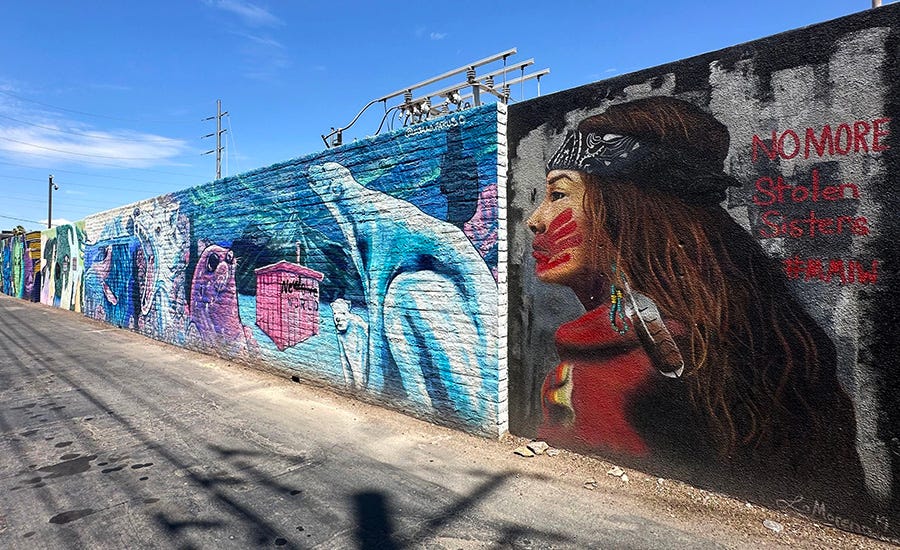
Phoenix is a monument to Man's arrogance Dude. Or so Peggy Hill tells me. Bummer about Little O's.
Another great travelogue but what was the record for home teams on your tour? The public needs to know Man!